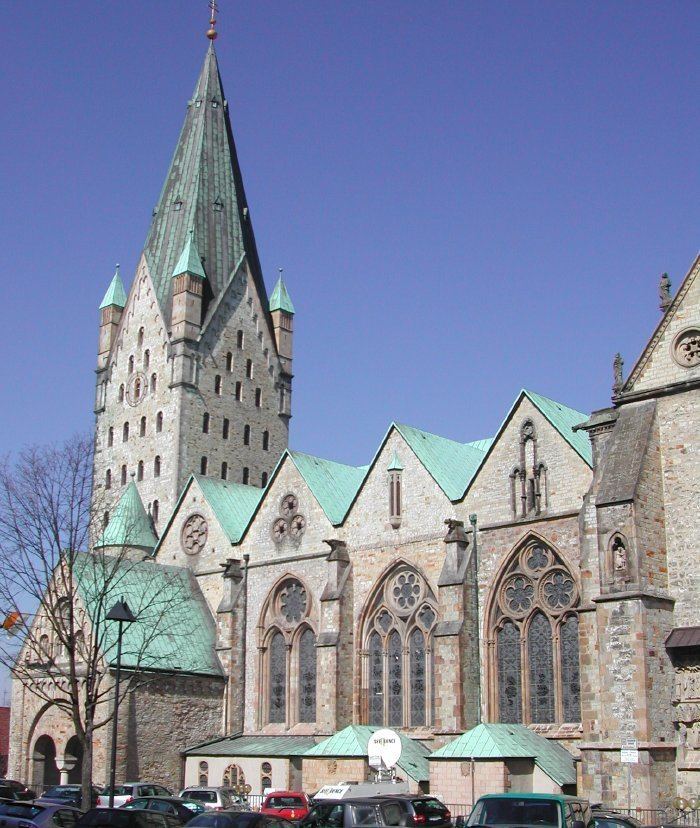Denomination Roman Catholic Functional status Cathedral Phone +49 5251 1251287 Archbishop Hans-Josef Becker | Status Active Founded 13th century | |
 | ||
Burials Johannes Joachim Degenhardt Similar Erzbischöflisches Dioezesanmuseum u, Museum in der Kaiserpfalz, The Jesuit Church in Paderborn, Pader, Börnepader | ||
Paderborn Cathedral (German: Paderborner Dom) is the cathedral of the Catholic Archdiocese of Paderborn. It is located in the city centre of Paderborn, North Rhine-Westphalia, Germany. The cathedral is dedicated to Saint Mary, Saint Kilian and Saint Liborius. The official German name is Hoher Dom Ss. Maria, Liborius und Kilian.
Contents
- Dom paderborn gottesdienst 01 07 2012
- Previous structures
- The current cathedral
- External dimensions
- Points of interest
- Crypt
- Window of Three Hares Dreihasenfenster
- Burials
- References
Dom paderborn gottesdienst 01 07 2012
Previous structures
Today's cathedral is located in a position that has been occupied by churches for hundreds of years. Charlemagne had a Kaiserpfalz built near the sources of the Pader river. As early as 777 this palace had an attached church, dedicated to Christ (Salvator Mundi) and Brigit of Kildare. This church, located north of today's cathedral, served as chapel to the court as well as a basis for missionary work among the Pagan Saxons. Rebellious Saxons repeatedly destroyed this first church. After the locals converted to Christianity, the first cathedral was built. Pope Leo III met Charlemagne at Paderborn in 799 and consecrated an altar to Saint Stephen, depositing some relics of that saint in it. The first cathedral of the newly established bishopric was a three-aisled basilica, dedicated to Mary and Saint Kilian. After the See was initially administered from Würzburg, in 806 Hathumar became the first Bishop of Paderborn.
The second bishop, Badurad, asked the Bishop of Le Mans for the remains of a saint, to help with consolidating the faith of the local Saxons. In 836, the remains of Liborius of Le Mans were handed over to a delegation from Paderborn and translated back to the cathedral. A fire destroyed the first cathedral in 1000 AD. Bishop Rethar began with rebuilding, but his successor Meinwerk had the previous work destroyed and started over, building a three-aisled church with a transept and crypt in the east. This (second) cathedral was consecrated in 1015, but destroyed in a city fire in 1058. Meinwerk's nephew, Imad had the cathedral rebuilt on a significantly larger scale (third cathedral). This building, with two transepts, already was very similar to today's cathedral. Today's crypt was built around 1100 AD. Similarly, a chapel to St. Bartholomew, connected to the cathedral, would be built after 1015 by Greek monks. Another fire in 1133 damaged the church, but its core survived. Bernhard I. von Oesede had the building strengthened and extended (fourth cathedral), it was reconsecrated in 1144/45.
The current cathedral
In the 13th century, the cathedral was reconstructed, not due to damage but to bring it up to then current artistic and ecclesial standards. Construction likely began at the western end of the building (late Romanesque basilika, before 1220). The nave followed in the form of a hall church (i.e. with three aisles all reaching to the height of the central roof) in early Gothic style. It was completed in the late 13th century with High Gothic elements.
In the 17th century, Prince-Bishops Dietrich Adolf von der Recke (1601-1661) and Ferdinand von Fürstenberg (1626–1683) replaced the Gothic interior features with Baroque artworks.
In 1930, the Diocese of Paderborn was promoted to Archdiocese.
Repeated Allied bombing of Paderborn in 1945 resulted in severe damage to the cathedral and the loss of irreplaceable works of art, including all the historic glass windows. On 22 March 1945, fourteen people were killed by a blockbuster bomb in the cloister.
Reconstruction took until the 1950s. From 1978-81, a major restoration was undertaken.
External dimensions
Points of interest
Crypt
The relics of Saint Liborius are kept in the three-aisled crypt, which is (with a length of 32 m) one of Germany's largest crypts. Towards the west are the tombs of the Archbishops of Paderborn. An antechamber features a 1935 mosaic on the walls and ceiling and in the centre of the floor the tombstone for Bishop Meinwerk, dating to the 13th century.
Window of Three Hares (Dreihasenfenster)
One of the cathedral's, and the city's, most recognisable features is the Dreihasenfenster ("Window of Three Hares"). It depicts three hares in motion, arranged in a triangle. Each hare is shown as having two ears, although only three ears are visible in total. The original 16th century carving can be found in the cloister's inner courtyard, and has been duplicated on numerous buildings and a number of shops throughout the city centre.
